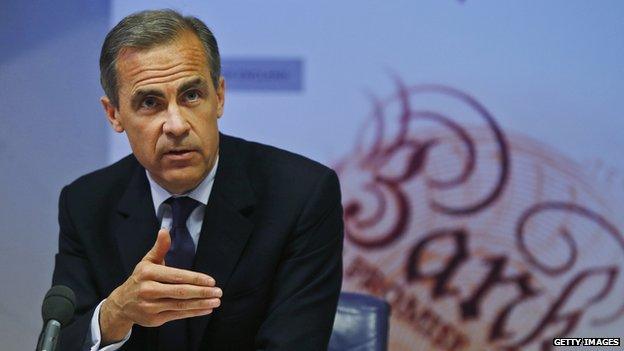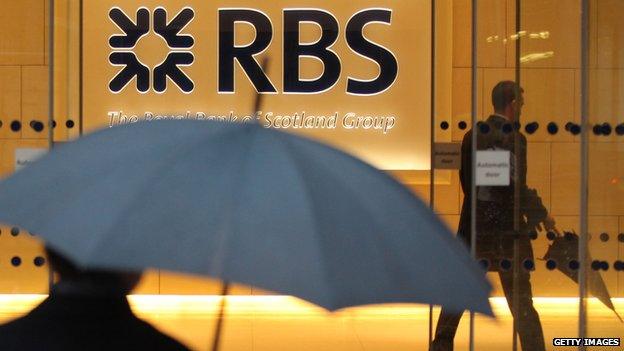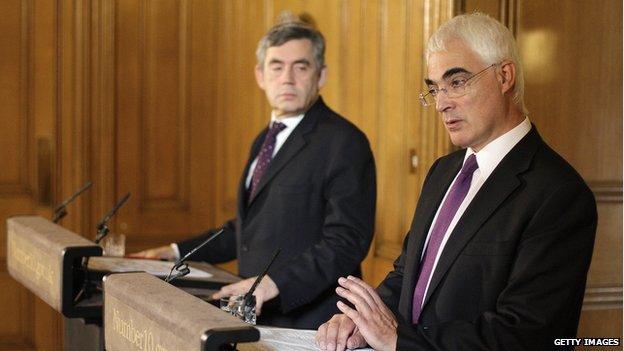Is 'too big to fail' for banks really coming to an end?
- Published
- comments

Interviewing Alistair Darling in 2011, three years after the financial crisis during which he was chancellor, his most striking answer to me was not about the fear that Britain's economic system was on the point of collapse.
It wasn't even his worry that ATMs up and down the country might simply stop functioning.
Those answers were of course chilling. But they were symptoms of a wider disease.
Mr Darling's most striking answer was the "absolute astonishment" he felt when he asked Britain's largest banks to account for the risks contained in their businesses - and they were unable to come up with a coherent answer.
This total lack of knowledge - coupled with the hubris of profit-taking built on lax credit - went to the heart of the financial crisis.
Regulators appeared similarly non-plussed.
Such was the global complexity and lack of governance in the international financial system, when it came to rescuing the banks from having to eat their own sick, the UK government - and many other governments around the world - initially had no idea how large the bill would be.
And neither did the banks.
Taxpayer as guarantor
The only funding avenues large enough to contain such unquantifiable risks were those provided by central banks and the taxpayer.
The alternative was financial meltdown.
The numbers turned out to be astronomical. A National Audit Office report in August this year suggested the value of the UK government's total support for the financial system alone exceeded £1.1tn at its height.
Many tens of billions of pounds worth of capital was directly injected into failing banks and building societies.
The rest of that dizzying £1.1tn was the total value of liability insurance - the government guaranteeing banks' security as lender of last resort.
Put simply, the taxpayer had become the guarantor of the global financial system and the banks that are the essential plumbing of that system.

RBS was bailed out by the government after being deemed "too big to fail"
In direct capital the UK government (the taxpayer) ultimately had to find over £100bn. More than £66bn was used to rescue the Royal Bank of Scotland (still 80% owned by the government) and Lloyds Bank (still 25% owned by the government).
Of that, the sale of two chunks of Lloyds since the last election in 2010 has raised the princely sum of £7.4bn.
UK Asset Resolution, the state agency charged with handling the collapse of those other lead players in the the financial crisis, Northern Rock and Bradford and Bingley, has so far paid back £12bn of a near-£50bn government loan.
What is clear is that the taxpayer is still a good deal out of pocket.
'Watershed moment'
Never again, went out the cry. At the G20 summit in London in 2009, world leaders from President Barack Obama to Gordon Brown demanded that the ugly canard of "too big to fail" - banks so large that their collapse would spark economic chaos - was brought to an end.
They demanded that the Financial Stability Board (FSB), a grouping of central bankers and financial policy makers, come up with a plan. Mark Carney, the governor of the Bank of England, is chairman of the FSB.
Today, after years of weighty policy documents and discussion, Mr Carney says that in the battle to end taxpayer exposure to failing financial institutions the world has reached a "watershed moment".
The FSB has published new standards on "loss absorbing capital" for all globally significant banks - major chunks of money banks will have to raise to ensure they have access to enough money to weather any future crisis without recourse to government coffers.
The FSB says banks will have to be able to access capital worth between 15% and 20% of their assets.
That is a very big number. Analysts suggest that the bill for this major amount of new capital could be as high as €200bn (£157bn) for Europe's banks alone.
Less lending?
The bill for American, Japanese and Chinese institutions which also make up the list of "globally significant banks" would be far higher.
As Roberto Nicastro, group general manager at UniCredit, told the Financial Times: "Banks would need to comply by further reducing lending activity."
And that could mean less money to support the economy.
So, is the taxpayer now protected?

The previous government was forced to spend billions bailing out banks to avoid financial collapse
Well, these new rules are unlikely to come into force until January 2019 at the earliest - so not yet.
And some economists are not convinced that in a systemic crisis any new regulations will be able to cope. In the teeth of an economic meltdown, could governments and regulators really organise the successful winding-down of failing institutions without the taxpayer once again footing the bill?
As we know, the best laid strategies of governments and regulators can come unstuck at the first contact with the enemy - events in the real world. The markets can gain a life of their own.
Mr Carney is sure banks are now safer than they were. And these new rules, which will be one of the main topics of debate at the G20 summit in Brisbane next week, will mean they are better prepared for the future.
Banks already have a lot more capital on their balance sheets to withstand global shocks.
"Living wills" - banks' emergency plans to be used in the event of a crisis - will eventually allow one part of a bank to be wound down in an orderly fashion without bringing down the whole operation.
That's the theory at least.
The UK's policy of "ring-fencing" - protecting the central retail bank from a collapse in investment banking activity - is also coming to help that process.
As is "bail-in" debt which means that investors carry the brunt of the cost of collapse. Rather than being paid back, they will be obliged to take an equity stake in the failing institution.
Central banks hope that will concentrate investors' minds on the stability of the bank rather than the short-term returns an institution can generate.
The end of "too big to fail"? Not yet. A major step on the journey? Mr Carney would like us to believe so.